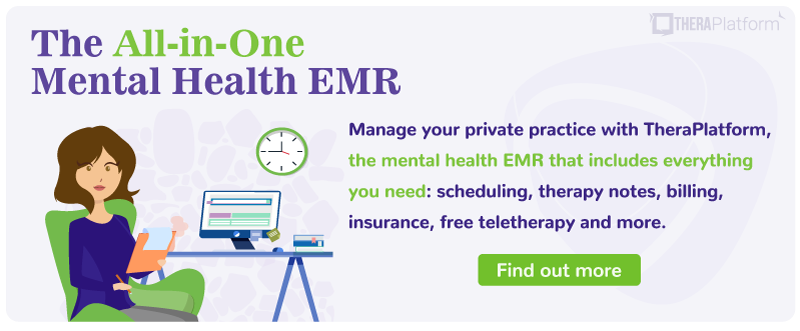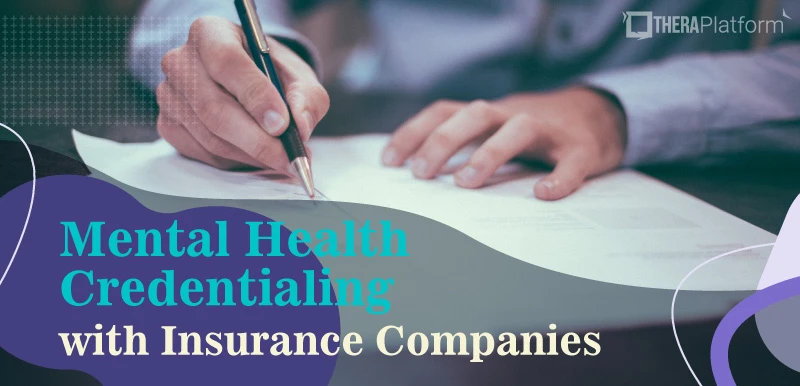Mental health billing

Mental health billing is when social workers, psychologists and psychiatrists use codes to file health insurance claims with carriers and governmental entities. Mental health billing is also one of the most difficult tasks for therapists in private practice. In order to bill, you need to be credentialed, understand diagnosis and treatment codes, verify eligibility and benefits, and then there’s invoicing, payment and follow-up. (There’s also your day job of treating clients, right?)
Best case scenario: Everything works well and you get paid. In the case of denied or rejected claims, however, you may find yourself in the stressful role of bill collector. Now you’re chasing down payments, following up with clients and payers while re-reviewing forms and submitting appeal letters. Fun.
The key to avoiding unnecessary administrative tasks around billing is developing a mental health billing process or strategy. The process involves several steps but can be simplified through preparation as well tools like practice management software.
Mental health credentialing
Credentialing is the first step in mental health billing and involves becoming an insurance panel member. Ultimately, you’ll be listed by an insurance company as an in-network therapist and gain access to new sources of clients. Additionally, your credentials follow you even if you change jobs – a nice bonus.
Credentialing requires high-level organization and you’ll need to have plenty of documents on hand to start including:
- A current CV and work history for the past five years
- Any certifications
- References
- Graduate school transcripts
Additional documentation requirements can be found at Mental health credentialing with insurance companies
Once credentialed, you’ll need to become proficient at what’s known in the biz as a clean claim, or a complete and accurate claim that is properly formatted. One good thing about mental health billing is that the CMS-1500 form is the industry standard used by most billing software platforms, clearinghouses and portals.
Mental health billing
Client data
Correct client data is crucial for mental health billing and you’ll need an accurate version of the following client data when ready to bill:
- Full name
- Date of birth
- Address
- Gender
- Plan member ID
- Insured person’s information if client is a dependent on a plan
Practice data
In terms of the diagnosis and care, as a therapist or mental health practitioner, you’ll need to provide:
- Full address of the practice location
- Dates and place of service
- Diagnostic/ICD-10 Code(s) (more on those below)
- Service code and modifiers for each date of service
- Service provider’s National Provider Identifier or NPI
- Practice NPI (may be different from service provider if billing under a group)
- Service provider’s taxonomy code
- Practice tax ID (may be different from service provider if billing under a group)
If you use software, you likely won’t need to enter this information each time, but will have it automatically completed each time you bill.
Mental health billing ICD-10 codes
ICD-10 refers to a system designed by the World Health Organization to catalog health conditions by categories of similar diseases under which more specific conditions are listed. The listings are referred to as the International Classification of Diseases and in this case, the tenth edition. While each specialty has its own codes, common codes for mental health billing are below.
Common anxiety ICD codes
Type of Anxiety Disorder | ICD - 10 Code |
|---|---|
Generalized Anxiety Disorder | F 41.1 |
Panic Disorder | F 41.0 |
Social Phobia | F 40.1 |
Specific (Isolated) Phobias | F 40.2 |
Common depression ICD codes include:
Condition | Code |
|---|---|
Mild depression | F32.0 |
Moderate depression | F32.1 |
Severe depression w/o psychotic symptoms | F32.2 |
Severe depression with psychotic symptoms | F32.3 |
Recurrent Depressive Disorder, Mild | F33.0 |
Recurrent Depressive Disorder, Moderate | F33.1 |
Recurrent Depressive Disorder, Severe without psychotic symptoms | F33.2 |
Recurrent Depressive Disorder, Severe with psychotic symptoms | F33.3 |
Seasonal Affective Disorder | F33.9 |
Dysthymia or Persistent Depressive Disorder | F34.1 |
Postpartum Depression | F53.0 |
While these codes tend to be used by mental health providers frequently, try to be as accurate as possible with your patient’s diagnosis if possible even if it means using a lesser known code.
Mental health billing using CPT codes
As a therapist, you’re likely familiar with mental health CPT codes which were created by the American Medical Association as a uniform language for describing diagnostic services. Mental health professionals including social workers, psychologists and psychiatrists use the same codes when filing health insurance claims with private health insurance carriers as well as Medicare and Medicaid. CPT codes help health insurance companies know what services were provided to the clients. You can see a list of commonly used codes in the table below.
Code | Description |
|---|---|
90837 CPT Code | 60-minute psychotherapy session (52 minutes or longer). Although this is usually called a 60-minute session, note that any session longer than 52 minutes gets billed with this code. Meetings must be face to face to use this code. |
90834 CPT Code | 45-minute psychotherapy session (38 to 52 minutes). Similar to above except for a shorter time. This may be the most used code in mental health. |
90832 CPT Code | 30-minute psychotherapy session (16 to 37 minutes). The 30-minute session is rarer but has occurred with increasing frequency in the telemedicine age. Note that you can see someone for only 16 minutes and still use this code. |
90791 CPT Code | Psychiatric Diagnostic Evaluation. How you would code the traditional intake session. For example, assessing the presenting problem and/or providing a mental status examination. |
90792 CPT Code | Psychiatric Diagnostic Evaluation with medical services. How a psychiatrist would code an intake session. The difference from 90791 is that a psychiatrist is a medical doctor who might assess the need for medical services, such as prescription medication. |
Family or couples psychotherapy, with the patient present (50 minutes). For use of family therapy techniques in a session with multiple family members or a couple. The identified patient must be present. | |
Family or couples psychotherapy, without the patient present (50 minutes). For use with family therapy technique sessions with multiple family members without the identified patient. This code is more controversial because the identified patient is not present. If you use this code too often, an insurance company may question why the identified patient is not included. | |
90853 CPT Code | Group Psychotherapy (not family). A treatment group for unrelated people, such as you might find for addiction or dialectical behavior therapy. Not the same as a support group. |
90839 CPT Code | Psychotherapy for Crisis, 60 minutes (30-74 minutes). This code is used in a crisis situation. If a patient is suicidal, for instance, and they require therapy to prevent self-harm and ensure stabilization. |
Some mental health CPT codes have a gray area and it’s good to understand coding complexities and how to bill based on specific situations.
Verifying eligibility and benefits
Verifying a client’s eligibility and benefits is where you’ll put your data gathering skills to the test. To check whether a patient’s eligibility, you’ll need to:
- Call the customer service phone number on the back of the client’s insurance card
- Request to verify mental health outpatient provider benefits and eligibility
- Share your TAX ID and NPI (remember those from above?) to determine whether you are in-network or out
- Share the patient’s info including name, date of birth, and subscriber ID
- Request the patient’s deductible, copay and coinsurance and ask for claims addresses.
Mental health claims submissions
Errors during the claims submission process can result in non-payment. Insurance companies are now requiring providers to use clearing houses to file their claims. Going through a clearing house can provide a safeguard against incomplete information as they scan for missing data and catch common human errors before the claims are submitted. While clearing houses can help you streamline mental health billing, for your benefit and the benefit of your clients, you’ll want to consider whether the clearing house is HIPAA-compliant, has the ability to track claims in real-time, its customer service reputation, usability and cost. Additionally, an EMR integrated with a clearing house can help you streamline all billing processes in a single tool, which can be a major time saver when it comes to mental health billing.
Start 30-day Free Trial and explore TheraPlatform. HIPAA Compliant Video and Practice Management Software for Therapists.
Mental health billing errors
Thousands of claims are rejected or denied annually and some of them are more easily remedied than others. Maybe it’s human error, for example. Other times, a client’s benefits may have changed or expired and the service is no longer covered.
Denial claims are different from rejected claims. Denials are claims that are received and processed but deemed unpayable by the payer. (Ugh.) And denials can be costly. In 2017, the Healthcare Financial Management Association reported that $262 billion or about 10% out of $3 trillion in submitted claims in all industries were denied. It’s projected that percentage might climb closer to 20% in 2022.
Rejected claims, on the other hand, are usually the result of error before the claim was processed.
To make sure your claim clears all of the mental health billing hurdles, avoid these common mistakes:
- Missing or incorrect CPT codes
- Service not covered by plan
- Incorrect health plan information
- Claim was not received by the health plan
- Patient or provider details were missing
To minimize claims errors, prior to providing services review contracts with the health plan around claim and pre-auth requirements as well as fee-schedule and adjudication, become pre-certified if required, and verify patient coverage ahead of treatment. When submitting the claim, double check its accuracy and completeness, follow payer’s requirements and check your procedure codes. Using an EHR can significantly reduce claim errors and result in more timely payment.
Following up on claims
If a claim is denied after you’ve taken these steps, review the submission for error and be timely about submitting a letter of appeal. Remember to keep your cool.
Summary
Although mental health billing may not be your favorite part of work as a therapist, organization, accuracy and automation can help streamline this part of your operations and allow you to focus more on treating your clients and growing your practice. TheraPlatform, an EHR, practice management and teletherapy tool, can simplify mental health billing. Sign up for a free, 30-day trial with no credit card required. Cancel anytime.
More resources
- Therapy resources and worksheets
- Therapy private practice courses
- Ultimate teletherapy ebook
- The Ultimate Insurance Billing Guide for Therapists
- The Ultimate Guide to Starting a Private Therapy Practice
Free video classes
- Free mini video lessons to enhance your private practice
- 9 Admin tasks to automate in your private practice





